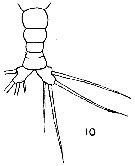
Issued from : C.C. Davis
in Trans. am. microsc. Soc., 1949, 68 (3). [p.253, Fig. 10].
Male (from off Chicken key, Florida): 10, urosome (dorsal view).
Nota: Single specimens were obtained from the channel between Belle Isle and Miami Beach, Florida (May25, 1947) and also in December 20, 1947; March 4 and 16, 1948.
Male: very similar to that of
M. reticulata (=
Monstrillopsis reticulata) Davis 1949, but differs in several important respects. Body considerably larger, more robust, setae on the various appendages and on the furcal rami much stronger
- Cephalic segment bears a rugose area on each side, just anterior to the position of the oral papilla.
- Oral papilla lies about 1/3 of the distance from the anterior margin of the segment.
- Eyes less conspicuous than in
M. reticulata, and frontal organ not pronounced.
- Anal segment very clearly marked off from the furcal rami, and much larger (than
M. reticulata).
- Anal segment and the penultimate segment partially fused together dorsally.
- Furcal setae are 4. One heavy seta is borne on the outer margin, 2 equally heavy are terminal, and 1, much finer and shorter on the inner margin.
- A1 similar to those of
M. reticulata, but the setae are much stronger and more numerous, and the terminal spine on the ultimate segment, shorter and heavier and not hooked. Ultimate segment with 1 or 2 setae, somewhat dichotomously branched.




